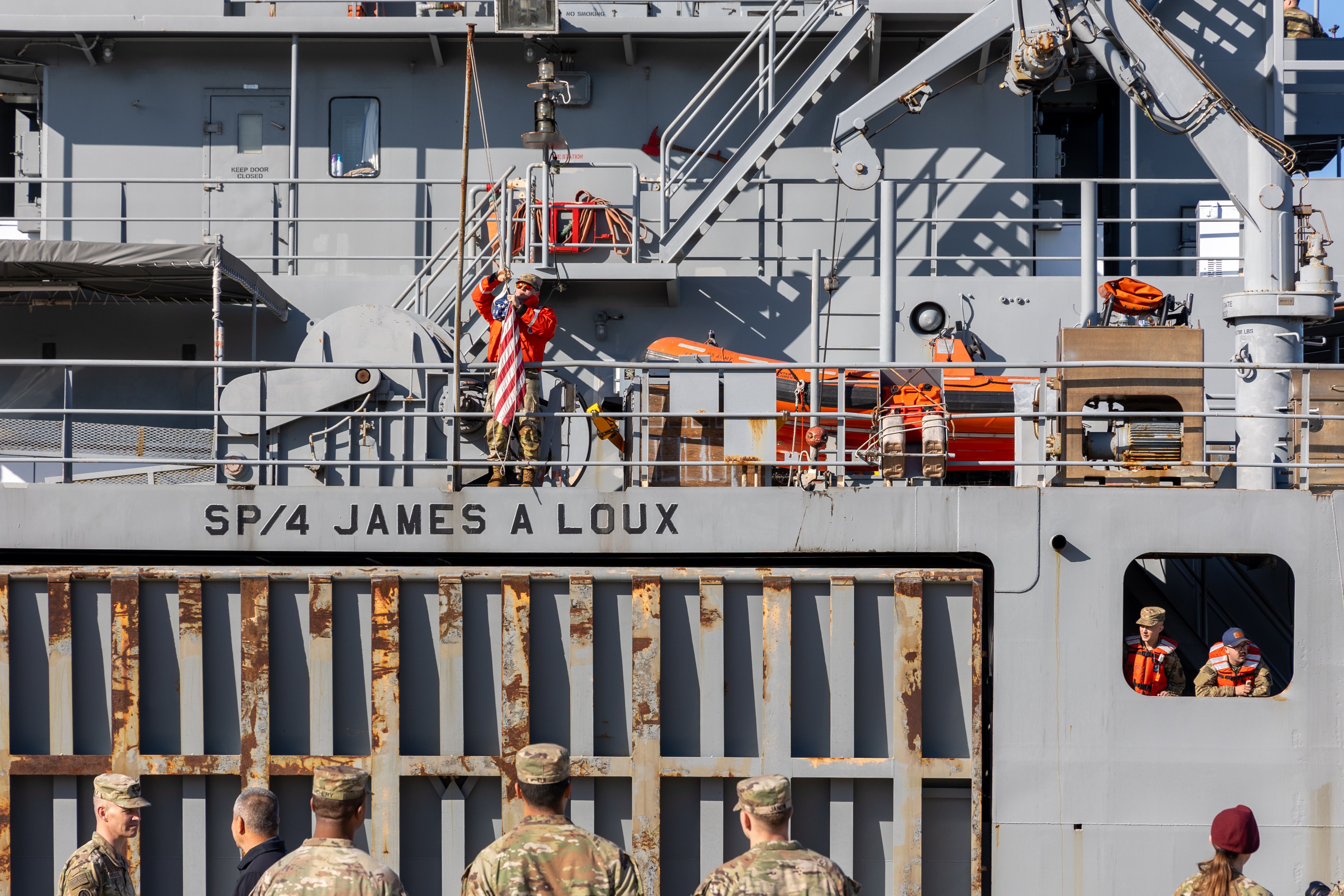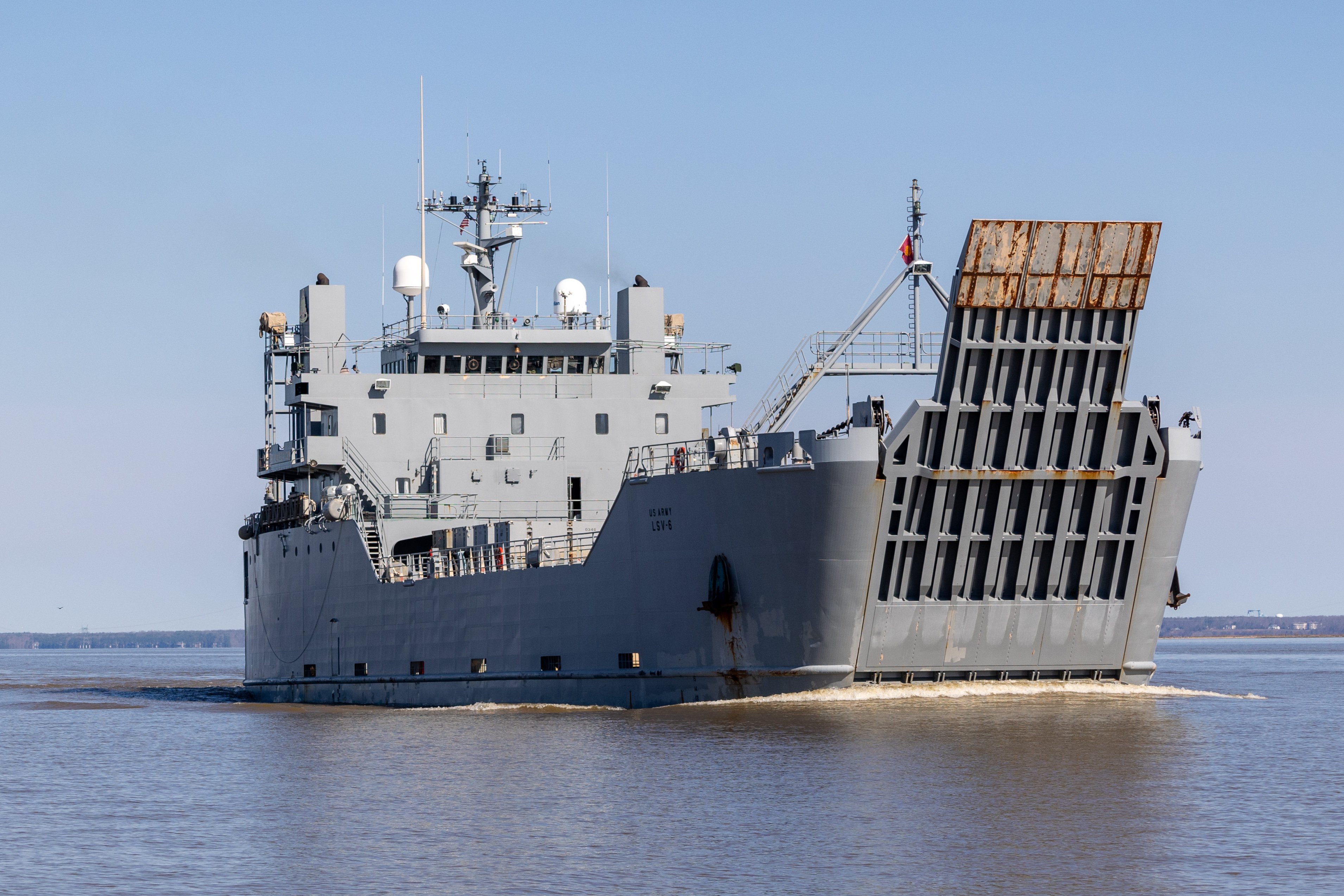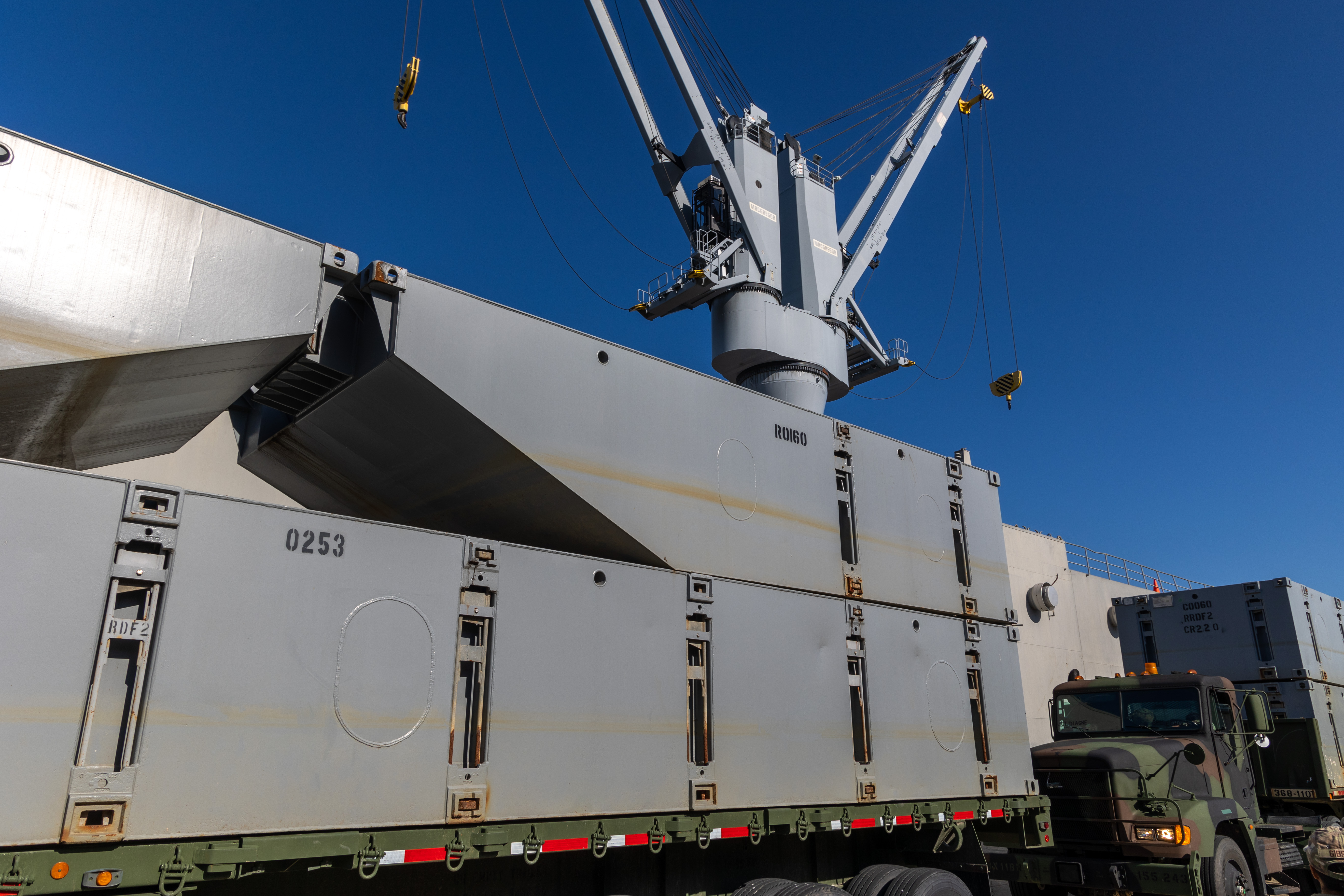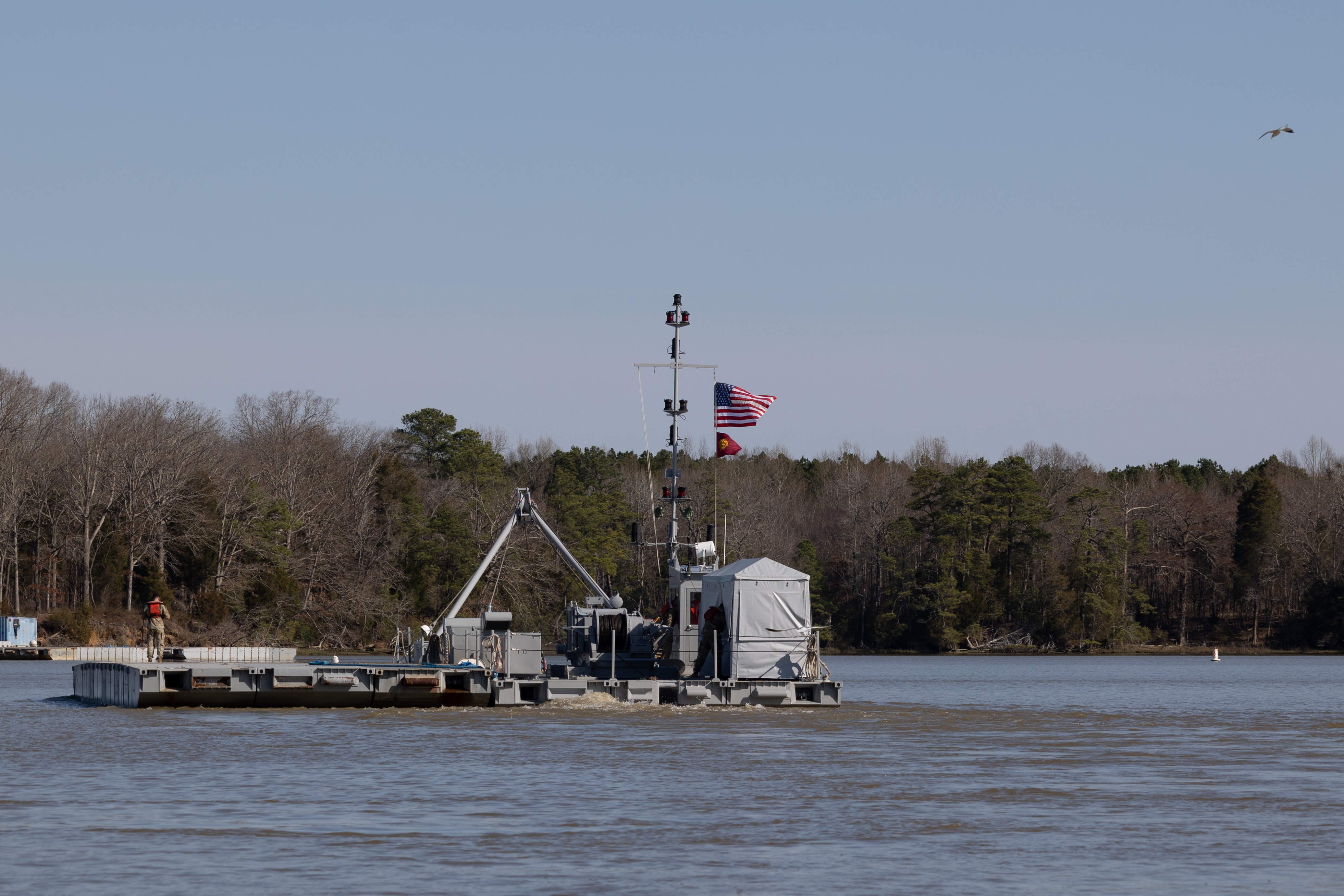
Fort Eustis, Va. – More pieces of the extensive Pentagon effort to build a pier and establish a sea route for humanitarian aid to Gaza departed from the East Coast this week.
On Tuesday, four Army watercraft left the pier at Fort Eustis, Va., sailing down the James River, to the Chesapeake Bay and the open Atlantic. Over the next 30 days, USAV SP4 James A. Loux (LSV-6) will sail at the head of a column of three smaller landing craft – USAV Montorrey (LCU-2030), USAV Matamoros (LCU-2026) and USAV Wilson Wharf (LCU-2011) – in a southern route across the Atlantic and into the Eastern Mediterranean Sea, off the coast of Gaza. On Sunday, USAV General Frank S. Besson Jr. (LSV-1) left the pier at Fort Eustis and more Army vessels are set to join the five that departed this week, officials said.
The flat-bottomed cargo ships, assigned to the 7th Transportation Brigade of the 18th Airborne Corps, are part of the 500-soldier contribution to the Army-led mission to establish a pier on a beach in Gaza to provide humanitarian aid to Palestinians who are trapped in the region. The mission is part of an international effort to create a maritime corridor for aid in the Eastern Mediterranean that will flow through Cyprus, amid a backlog of aid shipments via land crossings.
Announced during President Joe Biden’s State of the Union last week, the Gaza pier will allow humanitarian aid to flow over the beach at a rate of about 2 million meals a day, Army Brig. Gen. Brad Hinson, the assistant commanding general for support of the 18th Airborne Corps, told reporters on Tuesday. The combined transit of the material and construction for the pier will take about 60 days, Hinson said.

The Army will lead the joint logistics over-the-shore, known as JLOTS, operation using modular sections of floating causeway to create temporary piers to ferry goods ashore from deep-draft roll-on, roll-off vessels or container cargo ships.
Under the Gaza plan, Hinson said, the cargo ships will offload their cargo on floating platforms that are two to three miles off of the pier and the material will get ferried to the “trident” pier that will be anchored to the shore.
In his speech, Biden promised that the U.S. military would not set foot in Israel. At Fort Eustis, Hinson confirmed that the Pentagon and U.S. Central Command are looking for partners to help establish a beachhead and anchor the floating pier to the beach.
It’s unclear whether the U.S. has a partner on the ground to facilitate getting the aid ashore, nor is it clear when and where Israel will inspect the aid. The Israelis have historically controlled the waters off Gaza’s shore before the conflict began on Oct. 7.
“CENTCOM and DoD are working with partners over in the area. I’m not gonna go into the specifics of who we’re working with in order to anchor the pier, but we will have some assistance to be able to do that,” Hinson said.
“We will not be on the shore but we will be on the pier and that pier can extend anywhere out from shore from 800 feet up to 2000 feet.”

Additionally, it’s unclear where the cargo will be screened before entering Gaza, a condition Israel is putting on aid entering the region.
“We’re looking at different locations for [intermediate staging points] that are away from the area that would do the screening process for cargo before it gets on any U.S. vessel,” Hinson said.
“But the screening process is something we’re working through right now.”
A joint statement from the U.S., European Commission and several other countries announcing the maritime corridor last week identified Cyprus as the lead for the Amalthea Initiative that would oversee “securely shipping aid” to Gaza. On Tuesday, an aid ship affiliated with a Spanish non-governmental organization left Cyprus to ferry food to Gaza, the Associated Press reported. Celebrity chef Jose Andres’s organization assembled the food package.
Pentagon Press Secretary Secretary Maj. Gen. Pat Ryder told reporters last week that the JLOTS operation would require more than 1,000 U.S. troops to assemble and crew the pier, but he has emphasized that no U.S. service members will step foot on the shore.
On Tuesday, Navy officials told USNI News the service is dispatching Naval Beach Group 1 from San Diego, Calif., to assist with the operation.
“Naval Beach Group 1 is the sole Navy unit to conduct Improved Navy Lighterage System (INLS) missions. The INLS is a causeway system that resembles a floating pier comprised of interchangeable modules and is used to transfer cargo from ships to shore areas where conventional port facilities are unavailable or inadequate,” reads a statement from the Navy.

The service is also sending the logistics ship MV Roy P. Benavidez (T-AKR-306), a former military sealift ship that was transferred to the Maritime Administration’s Ready Reserve Force. Benavidez, a 35,000-ton Bob Hope-class roll-on, roll-off ship, is specifically designed to handle complex off-shore logistics missions, including carrying the modular pier components that make up the offshore platform. Given the ship’s reserve status it will take five days to get the ship ready and about two-weeks to transit the Atlantic, a Navy official told USNI News.
In addition to the Army vessels that departed on Tuesday, the modular pieces of the pier and the off-shore platforms – called the modular causeway system – are being assembled in the James River and will be carried separately by an unspecified strategic vessel, Hinson said.
The military practices JLOTS missions during joint exercises, including last year at Talisman Sabre 2023, which included the same Army unit performing the aid mission to Gaza.
“The capability provides a key logistic advantage for combat forces operating in areas lacking port infrastructure and can also be used to shuttle supplies to shore during humanitarian assistance operations,” the Defense Department said in a news release about the exercise last year.




